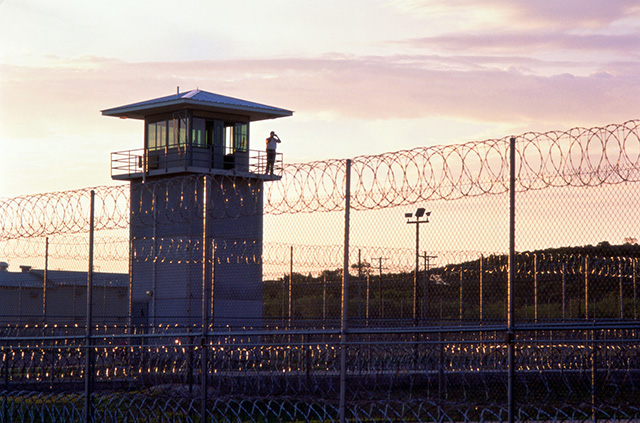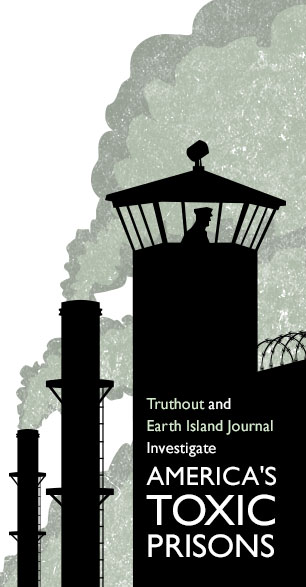
Part of the Series
America's Toxic Prisons
As an environmental reporter, it’s not every day that I get to communicate good news — the state of our environment often feels pretty bleak. But today, at least, there is a victory to celebrate: Thanks to the persistence of a small group of prison ecology advocates, the support of their allies, and the assistance of the U.S. Environmental Protection Agency (EPA), prisoners’ rights and environmental justice advocates have a new tool to add to their activist arsenal.
This summer, the EPA added a “prisons layer” to its Environmental Justice Screening and Mapping Tool. Known as EJSCREEN for short, the tool can be used by the public to assess possible exposure to pollutants that might be present in the environment (i.e., land, air, and water) where they live or work.
 The new layer allows the public to overlay the locations of the country’s 6,000-plus prisons, jails, and detention centers with information about environmental hazards like superfund and hazardous waste sites, something the nonprofit Human Rights Defense Center has been pushing for as part of its campaign for the EPA to consider prisoners within an environmental justice context. For the prison ecology movement, which addresses issues at the intersection of mass incarceration and environmental degradation, it could be a game changer.
The new layer allows the public to overlay the locations of the country’s 6,000-plus prisons, jails, and detention centers with information about environmental hazards like superfund and hazardous waste sites, something the nonprofit Human Rights Defense Center has been pushing for as part of its campaign for the EPA to consider prisoners within an environmental justice context. For the prison ecology movement, which addresses issues at the intersection of mass incarceration and environmental degradation, it could be a game changer.
“It’s huge,” says Panagioti Tsolkas, co-founder of the Prison Ecology Project, a program of the Human Rights Defense Center. “It’s one of those things that I think if you just look at it quickly, it seems almost mundane to have added a layer to this existing map. And in the absence of a movement present to actually use it for something, it could be meaningless…. But in the presence of what we’ve been doing over the last three years, of building this national movement and organizing model of looking at prisons from an environmental justice perspective, … this is pretty massive.”
The Prison Ecology Project was thinking of creating its own map in the absence of an EPA version. And during our own reporting on toxic prisons earlier this year, Earth Island Journal and Truthout attempted to create a map of prisons and superfund sites across the country, but struggled with a lack of adequate mapping tools.
Tsolkas thinks the new EPA tool will prove valuable in the fight against new prison projects. Prisons are often built on marginal lands that, after having been mined, logged, or otherwise contaminated, may not be seen as suitable for any other use. At the same time, the Federal Bureau of Prisons (BOP), a subdivision division of the U.S. Department of Justice, doesn’t typically address the impact of prison-siting decisions on the health of prisoners when completing federally mandated environmental impact statements (EIS).
That was originally the case with the proposed construction of a maximum-security prison atop a former mountaintop-removal coal-mining site in Letcher County, Kentucky. The BOP’s initial environmental impact statement for the project didn’t mention the potential environmental impacts — like mining-related pollution and water contamination — on the estimated 1,200 people who would be held at the prison if it were built. A revised EIS released earlier this year (following extensive comments by groups like the HRDC and the Center for Biological Diversity), mentions some of the health implications for prisoners, but does not provide a robust discussion of the impacts. According to HRDC, this EIS may represent the only example of an environmental review in which the BOP has made any mention of prisoner health. The final EIS for the new prison is still pending. (Read more about the status of the Letcher County proposal.)
Tsolkas says that the new EJSCREEN prison layer implicitly endorses HRDC’s contention that the BOP must consider prisoner health when evaluating the Letcher County project, and others like it.
“What the BOP has been saying is that they basically have no reason, no mandate, nothing that points them to have to look at environmental justice concerns related to prisons,” Tsolkas says. “And having the EPA include prisons on the EJSCREEN basically implies the opposite — that federal agencies now need to look at prison populations when they’re considering the placement of industrial facilities including prisons themselves.”
The new prison layer may also give prison ecology advocates the edge they need to go on the offensive. “Instead of reacting to abuses in existing prisons or responding to proposals for new prisons, we can actually initiate campaigns, and say, ‘Hey, this overpopulated prison has documented issues with x, y, and x.,” Tsolkas explains. “So we can create campaigns basically using the EJSCREEN tool.”
Tsolkas says he’d like “to give a shout-out to the folks at the environmental justice office of the EPA” for making the prison layer a reality. But he’d still like to see more from the agency, especially in the form of a robust national prison-inspection program.
Such a program is not without precedent. The EPA’s Region III office — which covers the Mid-Atlantic states of Pennsylvania, Virginia, West Virginia, Delaware, Maryland, and Washington, D.C. — used to run a “prisons initiative” to improve environmental compliance at prisons and jails across the region. Under the imitative, which ended in 2011, the EPA conducted inspections at prisons, and engaged in outreach and training work.
In a written statement, the agency said it ended the prisons initiative because it “felt prisons in the Mid-Atlantic region were able to ensure environmental regulation compliance by themselves.” It seems, however, that there is still room for improvement: A recent investigation by Earth Island Journal and Truthout found that mass incarceration impacts the health of prisoners, prison-adjacent communities, and local ecosystems across the United States.
“It shouldn’t be like pulling teeth,” Tsolkas says, referring to the difficulty of getting EPA inspectors out to prisons. “We have hundreds of letters from prisoners across the country saying the water is dirty. It shouldn’t take that much to get an EPA representative to go…. They have a key to get into the prisons that most of us don’t have short of visitation and breaking laws.”
This report is part of a collaborative series on the environment and mass incarceration by Earth Island Journal and Truthout. It was supported by a grant from the Fund for Investigative Journalism.
Our most important fundraising appeal of the year
December is the most critical time of year for Truthout, because our nonprofit news is funded almost entirely by individual donations from readers like you. So before you navigate away, we ask that you take just a second to support Truthout with a tax-deductible donation.
This year is a little different. We are up against a far-reaching, wide-scale attack on press freedom coming from the Trump administration. 2025 was a year of frightening censorship, news industry corporate consolidation, and worsening financial conditions for progressive nonprofits across the board.
We can only resist Trump’s agenda by cultivating a strong base of support. The right-wing mediasphere is funded comfortably by billionaire owners and venture capitalist philanthropists. At Truthout, we have you.
We’ve set an ambitious target for our year-end campaign — a goal of $250,000 to keep up our fight against authoritarianism in 2026. Please take a meaningful action in this fight: make a one-time or monthly donation to Truthout before December 31. If you have the means, please dig deep.